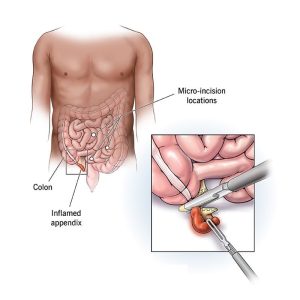Appendectomy
An appendectomy is surgery to remove the appendix when it is infected. This condition is called appendicitis. Appendectomy is a common emergency surgery.
The appendix is a thin pouch that is attached to the large intestine. It sits in the lower right part of your belly. If you have appendicitis, your appendix must be removed right away. If not treated, your appendix can burst. This is a medical emergency.
There are 2 types of surgery to remove the appendix. The standard method is an open appendectomy. A newer, less invasive method is a laparoscopic appendectomy.

Open appendectomy
A cut or incision about 2 to 4 inches long is made in the lower right-hand side of your belly or abdomen. The appendix is taken out through the incision.
Laparoscopic Appendectomy
This method is less invasive. That means it’s done without a large incision. Instead, from 1 to 3 tiny cuts are made. A long, thin tube called a laparoscope is put into one of the incisions. It has a tiny video camera and surgical tools. The surgeon looks at a TV monitor to see inside your abdomen and guide the tools. The appendix is removed through one of the incisions.
During a laparoscopic surgery, your provider may decide that an open appendectomy is needed.
If your appendix has burst and infection has spread, you may need an open appendectomy.
A laparoscopic Appendectomy may cause less pain and scarring than an Open Appendectomy. For either type of surgery, the scar is often hard to see once it has healed.
Both types of surgery have low risk of complications. A laparoscopic appendectomy has a shorter recovery time, and lower infection rates.

Why might I need an appendectomy?
You may need an appendectomy to remove your appendix if you show symptoms of appendicitis.
Appendicitis is a medical emergency. It is when your appendix becomes sore, swollen, and infected.
If you have appendicitis, there is a serious risk your appendix may burst or rupture. This can happen as soon as 48 to 72 hours after you have symptoms. It can cause a severe, life-threatening infection called peritonitis in your belly.
What are the risks of an appendectomy?
Some possible complications of an appendectomy include:
- Bleeding
- Wound infection
- Infection and redness and swelling (inflammation) of the belly that can occur if the appendix bursts during surgery (peritonitis)
- Blocked bowels
- Injury to nearby organs
- You may have other risks that are unique to you. Be sure to discuss any concerns with your healthcare provider before surgery.
You must not eat or drink anything for 8 hours before the surgery. This often means no food or drink after midnight.
What happens during an appendectomy?
In most cases an appendectomy is an emergency surgery and will require a hospital stay. You will have either an open appendectomy or a laparoscopic appendectomy. This will depend on your condition and your healthcare provider’s practices.
Open Appendectomy
A cut or incision will be made in the lower right part of your belly.
Your abdominal muscles will be separated and the abdominal area will be opened.
Your appendix will be tied off with stitches and removed.
If your appendix has burst or ruptured, your abdomen will be washed out with salt water (saline).
The lining of your abdomen and your abdominal muscles will be closed with stitches. A small tube may be put in the incision to drain out fluids.
Laparoscopic Appendectomy
A tiny incision will be made for the tube (laparoscope). More cuts may be made so that other tools can be used during surgery.
Carbon dioxide gas will be used to swell up your abdomen so that your appendix and other organs can be easily seen.
The laparoscope will be put in and your appendix will be found.
Your appendix will be tied off with stitches and removed through an incision.
When the surgery is done, the laparoscope and tools will be removed. The carbon dioxide will be let out through the cuts. A small tube may be placed in the cut to drain out fluids.


